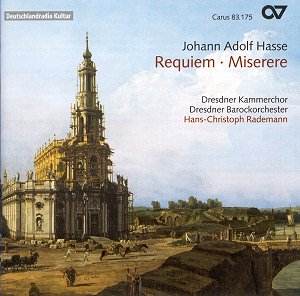Carus present is a
world premiere recording of this Requiem;
another requiem by Hasse is more frequently
performed, although I’ve never heard
it. It is one thing to read about the
influence of Italian composers on German
composers of this period, and quite
another to put on this disk of music
by Hasse and hear "Vivaldi"
coming out of the speakers! When Bach
tried to sound like Vivaldi he succeeded
in inventing Beethoven instead. Hasse
married an Italian prima donna
and they lived in Italy in his later
years.
Following the awesomely
solemn opening passage for tenors and
basses, the music is bright and bouncy
even during passages in the minor keys.
The performance is sufficiently operatic
that the excellent soloists are given
pauses in which to improvise cadenzas,
which they do with particular skill
and flair. The Dies Irae starts
off sounding like a direct steal from
the Mozart Requiem, but then
heads off on its own. The Lacrymosa
also sounds Mozartean. The Recordare
is a long florid soprano aria.
The Miserere in
d opens sounding much like a chorus
from Bach’s St Matthew Passion, but
develops very differently from Bach’s
style, more in a "modern"
style for the times, also very operatic
in the vocal writing. While the date
of this composition is not given, Hasse
was 14 years older than Bach and could
easily have become aware of his music
while he lived in Germany. Hasse wrote
it for a Venetian orphanage for them
to perform as a fund-raiser, so the
date of composition is likely to be
late. The final fugues in both works
are exquisitely crafted and very emotional.
Being located in the
suburbs, the Lukaskirche
largely survived the firebombing of
Dresden in World War II mostly losing
only the top of its steeple. Due to
roof damage, major repairs were required
after Germany was reunified, and today,
with its Silbermann organ fully restored,
the Lukaskirche is a sought-after recording
studio as well as a religious meeting
hall. During Hasse’s lifetime, Dresden
was destroyed in the Seven Years War
of 1756-1763. In 1764 Hasse said goodbye
to Dresden with this Requiem and moved
to Vienna and later to Italy.
Paul Shoemaker

![]() for
details
for
details





